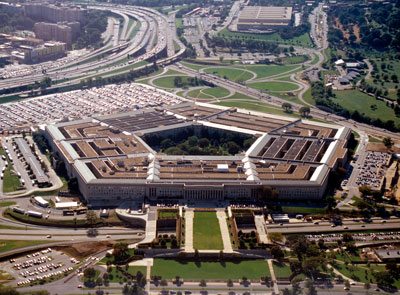A new book published by the Historical Office of the Secretary of Defense describes changes in military weapons systems acquisition during the 15 years following World War II.
“Rearming for the Cold War 1945-1960” by retired Air Force Col. Elliott V. Converse III is the first in a five-volume series of books focusing on the history of the acquisition of major weapons systems by the Defense Department. The book’s 766 pages contain a detailed examination of military acquisitions during the early years of the Cold War, and they are full of case studies, personality profiles, charts and photographs.
During a recent joint interview with AFPS and The Pentagon Channel, Converse said the book and its companion volumes were not written for historians. Rather the effort is “primarily aimed at the acquisition workforce, the people who do acquisition day-to-day and perform acquisition for their careers.”
It’s anticipated that defense policy decision makers would also gain something from the books, he added.
Converse earned a doctorate in history from Princeton University and served as the lead historian on the Defense Acquisition History Project team. During the joint interview, Converse said he was attracted to studying this “very dramatic” period of time.
“This was the beginning of the Cold War with the Soviet Union. When the Soviets launched Sputnik in 1957, Americans realized we might be vulnerable if they can put a satellite up there,” Converse said. “There was great concern that our weapons systems counter a threat like that. There was a lot of drama in the 1950s and 1940s.”
Following World War II, U.S. defense policy makers were convinced that the United States’ ability to maintain military supremacy rested on having superior technology, Converse said.
“One important thread that runs through the volume is the consensus that American leaders had at the end of World War II that the United States would seek security in the future by maintaining an advantage in the most technologically advanced weapons systems over any possible opponents,” he said. “They realized that the U.S. could not have an army as big as the Soviets or the Chinese or probably deploy as many systems as they could. So, the theory was that by having the most advanced systems, we’d be able to offset that advantage in terms numbers and equipment.”
That idea of the necessity of maintaining technological superiority to ensure national security affected how weapons systems were developed, produced and deployed, Converse said. It also determined how the Defense Department and the military services organized their acquisition efforts and led to changes in the acquisition workforce.
The book, he said, offers a prime example of how the United States’ perceived need to maintain an edge over its adversaries in advanced weapons technology affected the process of acquisition by its discussion of the acquisition strategy called “concurrency.” Using this approach, production activities would begin before the weapons system was fully developed and tested.
The strategy of concurrency “was in contrast to the way systems were developed before World War II,” Converse said, noting the pre-war system “was a sequential, deliberate system. You would design the weapon, you would develop the prototype, you would test it, you would produce it. All that would be done in series.
“By this new acquisition strategy,” he continued, “production activities began before development was completed. Sometimes, production contracts were let even before … an aircraft had ever flown its first flight. Prototypes, in terms of aircraft, were not generally developed. A new system was selected on the basis of a paper design competition.”
Concurrency was used on a limited basis during World War II, Converse said, and the Navy and Air Force tried to use the strategy after that war ended and before the Korean War started, attempting to speed up production by overlapping development and production. Once the Korean War began, he said, all the services adopted concurrency as an acquisition strategy.
“Its record was not very good during the Korean War,” Converse said. “A lot of the technologies needed for the advanced systems had not yet been developed, and some that had been developed were not proven sufficiently. Another problem was that the people defining requirements for new weapons systems often set requirements that were beyond the state of the art.”
In practice, he said, testing was often inadequate because of the haste to rush weapons systems out to the field, and they often discovered problems with the systems when they were fielded. Those problems frequently required that the systems had to be modified and changed, he added, which drove up cost and which meant that forces in the field still didn’t have systems that operated properly.
The problems associated with the strategy of concurrence were forgotten after the Korean War, Converse said, as the U.S. entered into an arms race with the Soviet Union to develop ballistic missile systems that could deliver nuclear warheads from continent to continent. Each of the services used concurrency in their acquisition programs to develop ballistic missiles, he said, and they encountered the same problems with concurrency that had been encountered during the Korean War. But the situation was now different.
“The difference was that these programs had the highest national priority, which meant that the program managers … all had generous budgets to get their jobs done,” Converse said. “They also had special authorities that exempted them from going through the different layers of bureaucratic approval necessary to get things done when they were developing their weapons systems. And these programs were great successes.”
Some of the systems were developed and deployed within four to five years which, according to Converse, was “an amazing amount of time for such advanced systems.” In the 1960s, he said, decision makers tended to overlook the problems associated with concurrency and it became the preferred acquisition method.
“Few people recognized that the reason the ballistic missile system program worked was that they had nearly unlimited funding and special authorities in those programs. Other programs did not have those, and that’s where problems with concurrency surfaced,” Converse said.
In response to those problems, by the 1970s the Defense Department went back to a more deliberate acquisitions strategy, Converse said.
“You didn’t go on the basis of paper designs. You would require two contractors, each to develop a prototype of the system. Then, those prototypes would be tested and, in theory, better decisions [would be] made,” he said.
Converse said understanding concurrency as an acquisition strategy during the Cold War is important because it addresses a central problem that still confronts the Defense Department.
“If your national strategy is to get security through having the most advanced technology, you have to deploy that technology rapidly and have it in the field so as always to maintain that edge over the opponent,” he said. “If that’s your strategy, then you have to find a way to insert advanced technology rapidly enough but at the same time to have it cost reasonably and overcome those problems I talked about before. That’s been a central dilemma.”
Since the 1950s, the United States has tried to find ways to maintain military technological superiority while dealing with the difficulty of rapidly fielding systems that might not yet be sufficiently developed or proven, Converse said, noting that’s “a problem that people working in the field today still face.”
Despite facing the same conundrum, Converse warned against trying to create exact analogies between current situations and those of the past.
“People have said that history does not repeat itself — it rhymes,” Converse said. “You can’t draw exact lessons from the past because the situations are not the same. … The value of history is that by taking a look at the past you can see how your predecessors in this field addressed problems. … History tends to broaden your perspective.”
Converse presented his book May 10 to an audience in the Pentagon during the second installment of the DOD History Speaker Series.
He was joined for a panel discussion by several other authorities. Benjamin F. Cooling, a professor at the Industrial College of the Armed Forces, set the book in the overall historical context of defense acquisition. Jacques S. Gansler, a former undersecretary of defense for acquisition, technology and logistics, offered his perspective on the book based on his experience managing DOD acquisition. Roy L. Wood, dean of the Defense Systems Management College, moderated the panel.
[Download not found]











